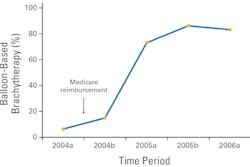The American Society for Radiation Oncology (ASTRO) has issued evidence-based guidelines for the use of palliative radiotherapy to treat bone metastases. The International Journal of Radiation Oncology, Biology, Physics published the guidelines online January 28.
Palliative radiotherapy treatments provide an efficient means to treat painful bone metastases effectively and cause very few side effects. External-beam radiotherapy provides relief in 50% to 80% of advanced cancer patients. Up to one-third of patients who receive this therapy achieve complete pain relief at the treated site.
Because widespread variation exists throughout the world with respect to palliative radiation dose fractionation schedules, ASTRO assembled a task force of 17 radiation oncology experts from Canada, the U.K., and the U.S. in October 2009 to develop evidence-based guidelines. The task force was also asked to investigate whether recent technological advances, such as stereotactic body radiotherapy, could improve the results of metastatic spinal lesion treatment.
The task force utilized the findings of 25 randomized clinical trials, 20 prospective single-arm studies, and four meta-analyses published in peer-review journals from 1998 through 2009, according to lead author Stephen Lutz, MD, a radiation oncologist at Blanchard Valley Regional Cancer Center.
Guideline recommendations
Electron-beam radiotherapy is the mainstay for treating bone metastases. The most common fractionation schemes include a single 8-Gy fraction, 20 Gy in five fractions, 24 Gy in six fractions, and 30 Gy in 10 fractions. All provide comparable initial relief.
Treatment in a single-fraction session offers the advantages of more efficient treatment for both patient and caregiver, at a lower overall cost. However, the need for repeat treatment is 12% higher than when multiple treatments are performed, at a repeat rate of 20% and 8%, respectively. The task force did not identify any long-term side effects from single-fraction treatment.
Repeat irradiation with electron-beam radiotherapy might be feasible in some circumstances, although the details of its effectiveness and safety are still to be determined. The task force recommended that caution be taken when repeat treatment would include the spinal cord, and suggested these patients be treated within the available clinical trial.
Stereotactic body radiotherapy can be considered for patients with a tumor in the spinal column or paraspinal areas. Patients should be entered into an appropriate clinical trial, and stereotactic body radiotherapy should not be the primary treatment of vertebral bone lesions causing spinal cord compression. The task force also recommended only cancer centers with considerable experience perform this treatment.
Bisphosphonates act effectively when combined with electron-beam radiotherapy, but a patient should not receive bisphosphonate treatment alone. The task force strongly recommended researchers conduct large prospective randomized trials to determine the most effective protocol for this combined treatment.
Use of radionuclides is most appropriate for patients who have several sites of painful osteoblastic metastases that cannot be conveniently or safely treated with electron-beam radiotherapy.
Surgical decompression, and stabilization plus postoperative radiation therapy, should be considered for some patients with single-level spinal cord compression, or spinal instability.
Copies of the guideline may be obtained free of charge by contacting ASTRO at [email protected].



















